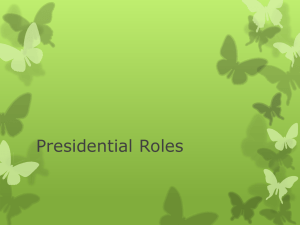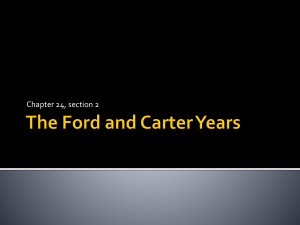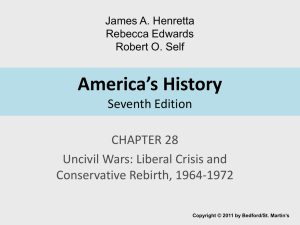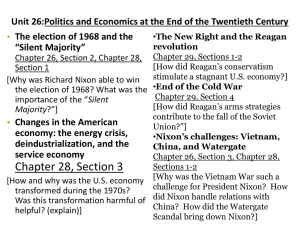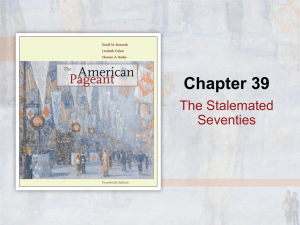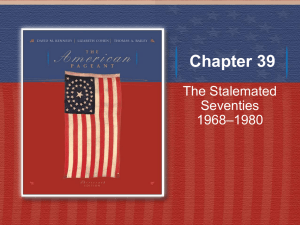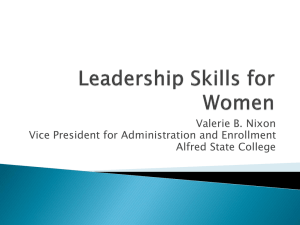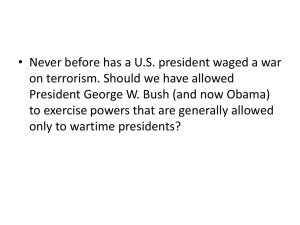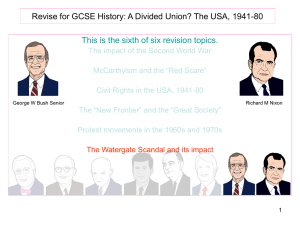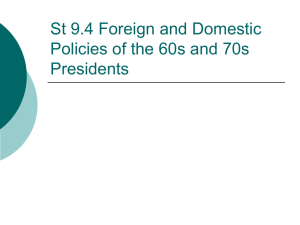President
advertisement
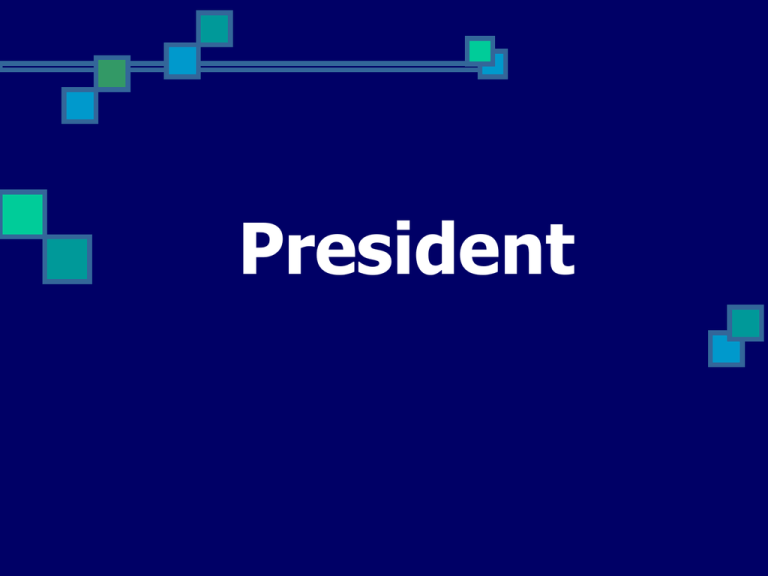
President Recent US Presidents: A Survey Who succeeded JFK in 1963? Lyndon Johnson Andrew Johnson A movie-star turned President JFK Ronald Reagan President who had served as ambassador to Mainland China Harry Truman George H. W. Bush Richard Nixon Recent US Presidents: A Survey President who had been a law professor Jimmy Carter Bill Clinton George W. Bush His counterpart in the United Kingdom today Prime Minister Tony Blair Queen Elizabeth II Queen and Prime Minister President of the United Kingdom The maximum time President can serve 4 years 8 years 10 years What does the President look like? He does not look like majority of the nation President has been someone who is male Caucasian Protestant Much older than 35 (average 54) US citizen at the time of election Well-educated Well-to-do Trained in legal professional Who can become President? Article II, Section 1, Constitution A natural born citizen 35 years of age 14 years residence in the U.S. Which one of the following is not eligible for being President? Someone born of American parents, but in a foreign country Someone born of Canadian parents, but in the US Who can become President? Article II, Section 1, Constitution A natural born citizen 35 years of age 14 years residence in the U.S. Can he run for President? Presidential Election Presidential primaries Election to choose the party’s candidates Party national conventions Time to formally nominate the party’s president and vice-president candidates General Election Voters vote for president indirectly Voters cast ballots for presidential electors Electors then vote for P and VP in the electoral college Majority vote in the college determine the winner House of Representatives decide if no winner Constitutional Roles of President Chief of State (head of state) as chief of state, President symbolizes the “dignity & majesty” of the American people Foreign counterpart Constitutional Roles of President Chief of State (head of state) as chief of state, President symbolizes the “dignity & majesty” of the American people Foreign counterpart Queen of UK Emperor of Japan Presidents of France, China, Russia Ceremonial functions of President Decorating war heroes Officiating the opening of baseball season Constitutional Roles of President Chief of State (head of state) Ceremonial functions of President Dedicating parks and post offices Receiving foreign heads of state Visiting foreign countries Making personal calls to astronauts Representing the nation at times of national mourning Constitutional Roles of President Chief Executive (Head of government) Foreign counterpart Prime ministers of UK, France, China, …. Executive powers Seek advise from department heads Nominate and appoint officers/officials Sign & issue Executive Orders “Don’t ask and don’t tell” order (1993) Enforce laws, rulings and int’l obligations Supervise and lead a federal executive bureaucracy of 2.7 million employees Constitutional Roles of President Chief Executive (Head of government) Foreign counterpart Executive powers Powers of Appointment and Removal Most government positions are filled by civil service employees President nominates some 5,332 positions President can remove appointed officials confirmed by Senate (1926, Supreme Court ruling) Constitutional Roles of President Chief Executive (Head of government) Foreign counterpart Executive powers The Powers of Appointment and Removal The Power to Grant Reprieves and Pardons Grant reprieves and pardons except in cases of impeachment Controversial Presidential pardons Gerald Ford: Richard Nixon Bill Clinton: Marc Rich Constitutional Roles of President Chief Executive As a legislator Call Congress into special sessions Report to Congress on the state of the union Submit legislative proposals Approve or veto legislations Sign legislative bills into law Veto & pocket veto bills Ignore a controversial bill Exercise line-item veto (1996-1998) Constitutional Roles of President As a legislator: Total Use of Veto President Truman Eisenhower # Used 250 181 Kennedy Johnson Nixon 21 30 43 Ford Carter Reagan Bush 66 31 78 44 Constitutional Roles of President Chief Executive As a chief diplomat Constitutional Roles of President Chief Executive As a head diplomat Represent the U.S. abroad Make & execute a foreign policy that safeguards US national interests Supervise the execution of U.S. international obligations Conduct diplomacy and maintain international relations Coordinate with foreign states and organizations in int’l crises Receive foreign ambassadors Extend diplomatic recognition to foreign states Negotiate and sign international treaties Negotiate and sign executive agreements Constitutional Roles of President President Nixon as a Head Diplomat The Start of Nixon’s Administration 1969 US & the World in 1969 Soviet global expansion Over-extension of US overseas commitment US forces in W Europe US forces in Korea US forces in Japan US forces in Vietnam Vietnam War & war protest at home “withdraw from Vietnam with honor” Vietnamization to end US involvement Constitutional Roles of President President Nixon as a Head Diplomat The Start of Nixon’s Administration 1969 US & the World in 1969 Nixon’s New Foreign Policy Explore relations with Communist China Rise of Communist China as a major power center Communist China in bitter conflict with USSR Communist China, a major supporter of North Vietnam Constitutional Roles of President President Nixon as a Head Diplomat Nixon’s China Initiative: a dangerous gamble Communist China, target of US containment in E Asia A Communist state Extremely anti-American and anti-West A party to the Korean War Aggressively supporting leftist regimes & armed rebels world-wide Sought the demise of capitalist West American public Knew little about China Except fortune cookies Constitutional Roles of President President Nixon as a Head Diplomat Nixon’s China Initiative: a dangerous gamble American public Knew little about China Except fortune cookies Anti-Communist sentiments Red Scare in the 1950s McCarthyism “China Lobby” & friends of “Free China” American existing commitment US support of the Chinese government in Taipei US support of anti-Communist regimes in Asia US long-time position against Communist China Constitutional Roles of President President Nixon as a Head Diplomat Nixon’s China Initiative: a dangerous gamble Execution of Nixon’s China’s Initiative Nixon made China’s initiative a top secret task Nixon sent signals to Beijing Nixon backed secret communications with Beijing Through Pakistan Through Romania Nixon personally in charge Congress not aware of it Vice President was told to be quiet American allies & friends not aware of it Constitutional Roles of President President Nixon as a Head Diplomat Nixon’s China Initiative: a dangerous gamble Execution of Nixon’s China’s Initiative Kissinger & Marco Polo Plan First US officials’ visit to Communist China Laying the ground work for Nixon’s trip to Beijing Nixon’s TV announcement Significance Détente with USSR US-China ‘alliance’ against Moscow US withdrawal from Vietnam (1973) Constitutional Roles of President President as Commander in Chief President is the civilian leader of the armed forces President has long been assertive in military decision-making President William McKinley & US troops into Beijing (1900) President Truman & Hiroshima/Nagasaki President Truman & Korean War President Kennedy & Cuban Missile Crisis President Johnson & bombing of N Vietnam Constitutional Roles of President President as Commander in Chief President has long been assertive in military decision-making President Nixon & Invasion of Cambodia (1970) Presidential Power Questioned The War Powers Resolution (1973) President must notify Congress within 48 hours when sending troops overseas President must pull back troops within 60 days unless Congress agrees to extension Constitutional Roles of President President as Commander in Chief President has long been assertive in military decision-making Presidential Power Questioned After the War Powers Resolution US troops to Lebanon & Grenada (1983) Air-raid on Tripoli (1985) Invasion of Panama (1989) US troops to Somalia (1992) US troops to Haiti (1994) Missile attack on a Sudanese chemical plant (1998) Aid raid on Serbia (1999) Presidential Powers in Summary Constitutional Power A power vested in the president by Art. II of the Constitution Chief executive Commander in chief Statutory Power A power created for the president thru laws made by Congress Line-item veto power to President (Line-item Veto Act, 1996) Presidential Powers in Summary Constitutional Power Statutory Power Expressed Power A constitutional or statutory power of the president that is expressly written into the Constitution and into statutory laws. Constitutional power + statutory power Inherent Power Power derived from presidential power in laws and constitution President’s power to send troops overseas President’s power to recognize foreign states Presidential Powers in Summary Inherent Power Emergency Power Inherent power or derived power Power exercised by the president in times of extraordinary situations US v. Curtiss-Wright Export Corp (1936) FDR ordered arms embargo against 2 warring states in S America without Congressional authorization Lincoln’s suspension of civil liberties (1861) Truman seizure of steel plants (1952) to safeguard steel supply in times of strike Presidential Powers in Summary Inherent Power Emergency Power Executive Privilege An inherent executive power concerning the need of the president or his executive officials to refuse to appear before, or to withhold info from, Congress or the courts. President Bush refused to allow Homeland Security Sec Tom Ridge to testify before Congress President Bush refused to share info about Dick Cheney’s chairing an energy policy task force Nixon’s use of the power to withhold tapes foiled Clinton refused testimony by presidential guards The Executive Organization The Growth of the President’s Office George Washington answered most of his mails First private secretary authorized by Congress (1857) & paid by federal government Woodrow Wilson typed most of his correspondence FDR in 1933 had total staff of 37 people FDR appealed to Congress to increase White House staff (1937) Today’s White House=600 staff The Executive Organization The Cabinet No constitutional status Members of the Cabinet Cabinet: a formal source of information Secretaries of various departments National security advisor Ambassador to the UN Yet, it often rubberstamps president’s decisions “Kitchen cabinet” A group of close friends and advisors who serve as an informal source of information to the President The Executive Organization The Executive Office of the President Created in 1939 by FDR thru an executive order authorized by Reorganization Act Consisting of 11 staff agencies that assist the president in carrying out major duties 11 Offices The White House Office Council of Economic Advisers National Security Council Council on Environmental Quality Office of Management and Budget The Executive Organization The Vice President Office Purposes of the Office Succeed in case of resignation, death, or incapacitation Preside over Senate & cast a tie-breaking vote When Vice Presidency Becomes Vacant 25th Amendment (1967) President nominates & majority vote of both houses Succession Act of 1947 If both President & Vice President die, Speaker of House shall succeed President pro tem of Senate Secretary of State The Executive Organization The First Lady Ceremonial portion of the Presidency Greeting foreign dignitaries, visiting foreign countries, and attending important ceremonies Not subject to media scrutiny and partisan attack A symbol of the nation Hillary Clinton: a symbol or a politician? Political Resources of the Presidential Power Election Party Landslide victory Narrow electoral results President of a majority party President of a minority party Media Use of media to support a program Use of media to aspply pressures Use of media for election purposes Political Resources of the Presidential Power Election Party Media Public Opinion Shape public opinion Follow public opinion when necessary Mass popularity Use of high approval rating To pressure Congress To make policy initiatives
